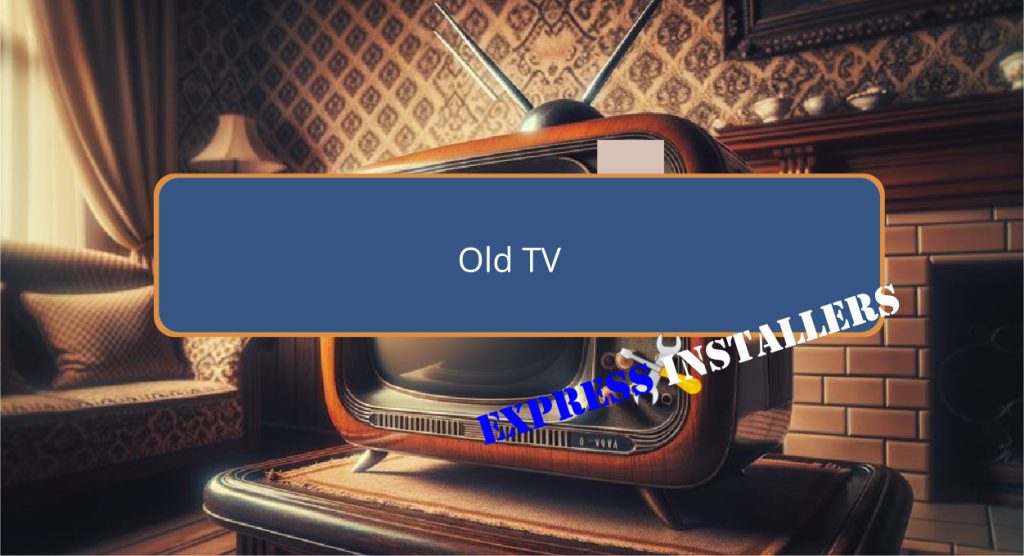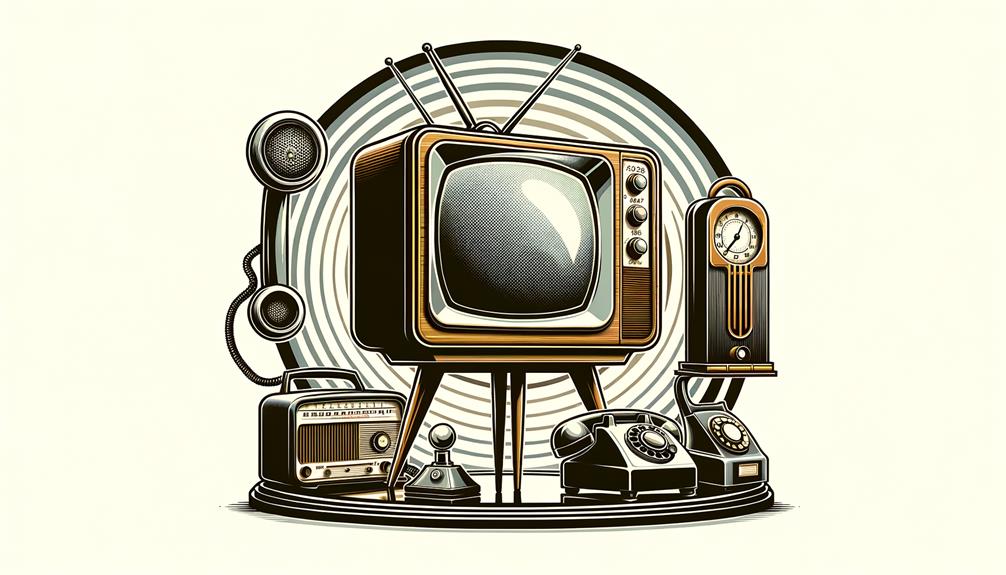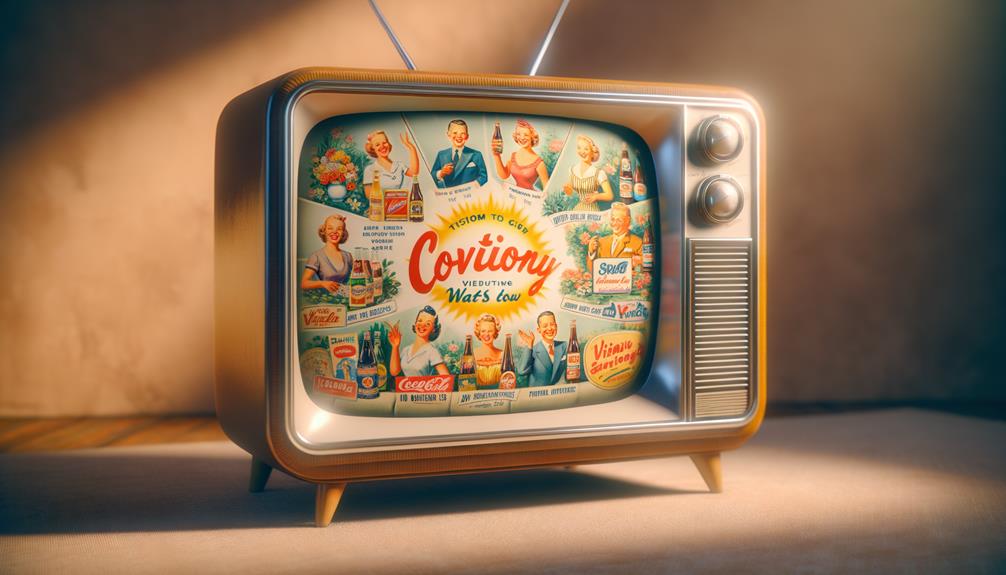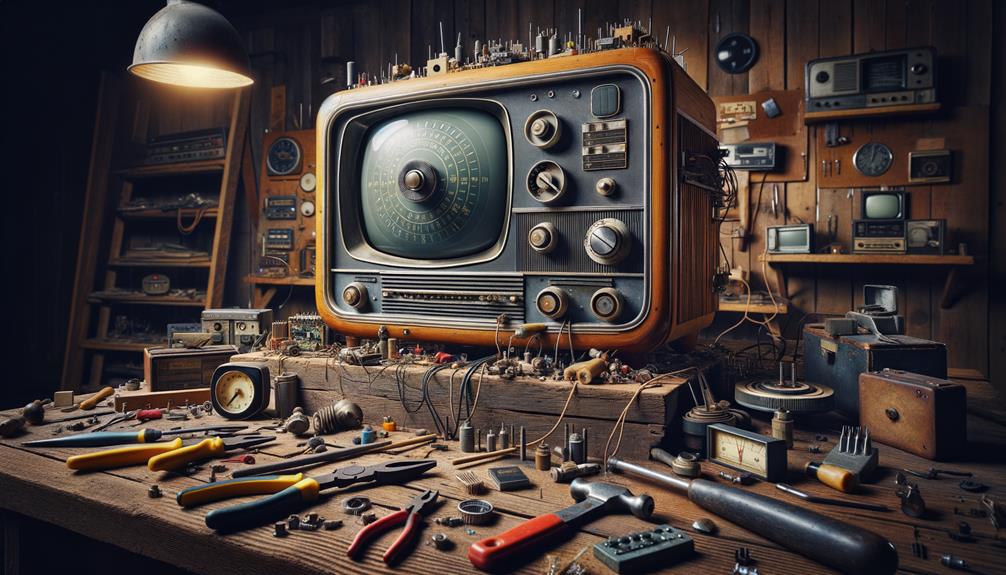
Old TVs, embodying eras past, represent not just technological evolution but also cultural transformation.
Iconic brands like RCA and Zenith pioneered models that became household staples, epitomising both style and function.
These televisions witnessed the shift from monochrome to colour, fundamentally altering viewer experience and content creation.
Families gathered around these sets, forming emotional bonds and shared memories underscored by groundbreaking shows and events.
Each model, from bulky consoles to sleek designs, traces a distinct chapter in media history, reflecting shifts in consumer aesthetics and technological capabilities.
Exploring their legacy offers a deeper appreciation of how these devices shaped modern media landscapes.
Quick Summary
- Old TVs often feature bulky designs with wooden or bakelite cabinets and prominent dials.
- Iconic brands like RCA, Zenith, and Sony produced culturally significant TV models.
- Restoration of old TVs involves cleaning components, replacing parts, and recalibrating displays.
- Vintage televisions include collector’s editions that are highly valued for their historical importance.
- Technological advancements in old TVs, such as the introduction of color broadcasting, significantly influenced media consumption.
The Dawn of Television

The dawn of television marked a revolutionary transformation in media, profoundly altering how societies consumed news and entertainment.
As the glowing screens flickered to life in homes, broadcasting legislation swiftly evolved to guide this powerful medium.
Governments recognised the need to regulate airwaves, balancing public interest with innovation.
This era saw the crafting of policies that shaped content delivery and influenced the burgeoning industry’s trajectory.
Simultaneously, viewer demographics began to emerge as a critical focus.
Networks and advertisers keenly analysed audience segments to tailor programming—dramas appealed to some, while others were drawn to news broadcasts.
This granular understanding of viewer preferences significantly steered the development of early television programming, embedding TV deeply into the cultural fabric.
Iconic Models and Brands
As television solidified its place in cultural history, certain models and brands emerged as icons, epitomising the era’s technological and design aspirations.
Collector’s editions of these models today fetch significant attention and prices in auctions.
Brand rivalries, especially between RCA and Zenith, fuelled a surge in innovation and design aesthetics that still capture the imagination of enthusiasts.
| Brand | Iconic Model | Year Released |
|---|---|---|
| RCA | RCA CT-100 | 1954 |
| Zenith | Zenith G2320R | 1963 |
| Philco | Philco Predicta | 1958 |
| Sony | Sony Trinitron | 1968 |
Each model reflects a chapter in television history, where design and brand identity played pivotal roles in shaping what would become lifelong memories for many viewers.
Technological Milestones

Marking significant advances in television technology, colour broadcasting emerged as a landmark achievement when RCA introduced the CT-100 in 1954.
This innovation not only transformed the viewer experience but also prompted changes in broadcasting legislation.
This ensured a standardised shift from black-and-white to colour TV across networks.
The demographic landscape of viewers widened substantially as families gathered to enjoy the richer, more engaging visual content.
Colour TV played a pivotal role in shaping the television market’s expansion, influencing programming and advertising strategies to cater to a diverse audience.
Reflecting on this era brings a sense of nostalgia for the time when television was redefining entertainment and connectivity.
Design Evolution
Television design has undergone significant transformations since the introduction of the RCA CT-10.,
Evolving from bulky, box-like consoles to sleek, wall-mounted displays that blend seamlessly into modern living spaces.
This shift reflects not only technological advances but also changes in material aesthetics and viewing habits.
Initially, wood veneer and bulky cathode ray tubes dictated the design, anchoring televisions to specific, immovable locations within a room.
As materials evolved to lighter plastics and metals, televisions became more versatile, influencing and adapting to the increasingly fluid lifestyle of users.
Today’s ultra-thin screens support a minimalist aesthetic, promoting mobility and redefining the concept of a home entertainment system.
These changes have continually reshaped how viewers integrate technology into their domestic environments, enhancing both functionality and visual appeal.
Cultural Impact

The cultural impact of television extends beyond its physical design, profoundly shaping societal norms, family dynamics, and individual worldviews.
The evolution of old TVs has not just been a technological journey but also a cultural expedition, reflecting and influencing the fabric of society in significant ways:
Normalisation of Shared Experiences: Television became a communal hub, establishing a unified field of entertainment and information.
Modification of Viewing Habits: The rise of scheduled broadcasts dictated the daily routines and leisure activities of families.
Transformation in Social Interactions: TV programs sparked conversations, debates, and a shared cultural lexicon.
Influence on Perceptions: Television shaped perceptions about lifestyle, success, and values, subtly weaving itself into the viewer’s decision-making framework.
Memorable TV Shows
Nostalgia envelops the discussion of memorable TV shows, which have left indelible marks on the cultural landscape and personal memories alike.
The profound character development observed in shows like ‘M*A*S*H’ and ‘Cheers’ not only entertained but also offered a deeper understanding of the human condition.
This rich unfolding of characters’ lives encouraged viewers to form a lasting emotional connection, ensuring these shows’ places in television history.
Additionally, successful spin-off series such as ‘Frasier’ from ‘Cheers’ demonstrated the potential to extend beloved worlds and explore new facets of familiar characters.
This phenomenon allowed for the sustainability of storytelling and the enrichment of the original narrative universe.
Advertising Golden Age

During the mid-20th century, the advertising industry experienced a transformative era, often referred to as its Golden Age.
This is characterised by revolutionary strategies and iconic campaigns that reshaped consumer culture.
This period saw the development of:
- Celebrity Endorsements: Utilising the widespread appeal of movie stars and athletes to forge a deeper connection between consumers and products.
- Slogan Creation: Crafting memorable, catchy phrases that encapsulated brand identities and values, often becoming part of the vernacular.
- Creative Television Commercials: Combining storytelling with product promotion, which notably increased consumer engagement.
- Psychological Targeting: Employing emerging psychological insights to tailor advertisements, enhancing consumer resonance and response.
These strategies collectively not only advanced advertising methodologies but also indelibly influenced the consumer landscape, embedding brands into the fabric of everyday life.
The Shift to Color
Shifting to colour television in the 1960s marked a significant evolution in visual broadcasting, enhancing viewer experience and opening new avenues for advertising creativity.
This transformative period was not without its hurdles; the colour conversion challenges included high costs of production and initial reluctance from broadcasters to invest in the new technology.
The societal reception, however, gradually shifted from scepticism to enthusiasm as the vividness of colour broadcasts brought a new dimension to television viewing.
Audiences experienced a more immersive and engaging form of entertainment, influencing social trends and expectations.
This period nostalgically reflects an era of innovation and excitement, as the public’s fascination with colour TV turned into a cultural milestone, reshaping the broadcast landscape forever.
Restoration and Collecting

As colour television firmly established itself as a standard, enthusiasts began to appreciate the historical and aesthetic value of older, monochrome models, prompting a surge in the restoration and collecting of vintage televisions.
This niche hobby not only preserves a significant part of broadcasting history but also showcases intricate craftsmanship.
Key aspects of restoring these antique devices include:
- Component Sourcing: Locating authentic parts, such as vacuum tubes and early transistors, is essential for maintaining the original functionality and value.
- Cabinet Restoration: Refurbishing the wooden or bakelite exteriors to their former glory.
- Repair Techniques: Utilising era-appropriate tools and methods to address electrical and mechanical failures.
- Display Calibration: Ensuring the picture tube displays clear, accurate images.
These steps require a blend of technical skills and historical knowledge, making the restoration both a challenging and rewarding endeavour.
Legacy and Influence
While the fascination with vintage televisions has grown, it has also greatly influenced contemporary media culture, reminding us of the foundational technologies that shaped today’s entertainment landscapes.
The nostalgia for old TVs isn’t merely aesthetic; it extends into how broadcasting laws were crafted, reflecting a time when regulations had to adapt to the rapid technological advancements and the societal impact of mass media.
This historical context helps us understand current policies and viewer habits.
As people today watch series on sleek digital devices, the communal viewing experiences fostered by those bulky boxes of yesteryears laid the groundwork for our modern media consumption patterns.
This illustrated a profound transformation from appointment viewing to streaming on demand, yet still shaped by those early broadcasting principles.
Frequently Asked Questions
How Did Early TV Broadcasts Handle Power Outages?
Early broadcasts mitigated power outages with backup generators, ensuring continuity. Technicians prioritised rapid signal restoration, maintaining transmission integrity and viewer satisfaction, reflecting a resilient yet nostalgic era of pioneering broadcast technology.
What Were Common Repair Issues With the First TVs?
Common repair issues with early televisions included frequent tube replacements and meticulous signal calibration to guarantee top-notch reception and picture quality. These challenges underscored the technical complexities of pioneering electronic entertainment devices.
Were Old TVs Susceptible to Weather Conditions?
Yes, early television sets were particularly vulnerable to various weather conditions. Sunlight glare could wash out images, and high humidity levels often led to internal component damage, impacting overall performance and longevity.
How Did Children Interact With TVs in the Early Days?
In the early days, children’s interactions with televisions were largely shaped by family viewing habits and the availability of educational programming, fostering communal watching experiences and influencing both leisure and learning environments at home.
Did Early TVs Have Any Hidden Features or Easter Eggs?
Early televisions lacked hidden features or Easter eggs commonly found in modern devices. They primarily focused on basic functionality, with remote controls and channel surfing emerging as innovations in later models.
Conclusion
The evolution of television represents a significant chapter in technological and cultural history.
As it evolved from monochrome to colour, television not only mirrored technological advancements but also shaped societal norms and aesthetics.
The legacy of early television continues to influence contemporary media landscapes, underscoring its role in the genesis of modern visual culture.
Collectors and historians alike preserve this rich heritage, ensuring that the early days of television continue to inspire and educate future generations.
